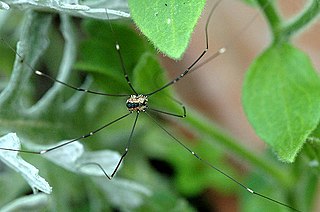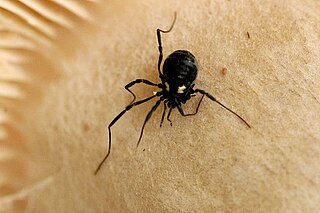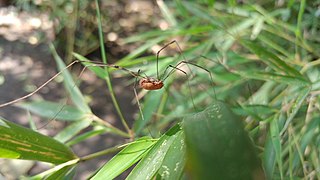
Metaphidippus is a genus of jumping spiders that was first described by Frederick Octavius Pickard-Cambridge in 1901. The name is combined from Ancient Greek μετά "after, beside" and the salticid genus Phidippus.

Lycosa is a genus of wolf spiders distributed throughout most of the world. Sometimes called the "true tarantula", though not closely related to the spiders most commonly called tarantulas today, Lycosa spp. can be distinguished from common wolf spiders by their relatively large size. This genus includes the European Lycosa tarantula, which was once associated with tarantism, a dubious affliction whose symptoms included shaking, cold sweats, and a high fever, asserted to be curable only by the traditional tarantella dance. No scientific substantiation of that myth is known; the venom of Lycosa spiders is generally not harmful.

Pachylinae is the most diverse subfamily of the harvestman family Gonyleptidae, including around 400 valid species. Major groups of species occur in the Brazilian Atlantic forest, Bolivian/Peruvian highlands, Argentina, and Chilean temperate forest.

The Phalangodidae are a family of harvestmen with about 30 genera and more than 100 described species, distributed in the Holarctic region.

The Sclerosomatidae are a family of harvestmen with about 1,300 known species. One former subfamily has been recently removed to form a new family, Globipedidae.

The Triaenonychidae are a family of harvestmen with about 120 genera and more than 440 described species.

Leiobunum is a genus of the harvestman family Sclerosomatidae with more than 100 described species. Contrary to popular belief, they are not spiders, although they share a resemblance. They are arachnids, in the order Opiliones, harvestmen. Species in Leiobunum tend to have relatively long legs compared with other harvestmen, and some species are gregarious.

The Nemastomatidae are a family of harvestmen with about 170 described species in 16 recent genera. Several fossil species and genera are known.
The Stygnopsidae are a small family of harvestmen, with almost all species found in Mexico.
The Stygnidae are a family of neotropical harvestmen within the suborder Laniatores.
Agoristenidae are a neotropical harvestman family of the Suborder Laniatores, in the superfamily Gonyleptoidea.
The Manaosbiidae are a family of neotropical harvestmen within the suborder Laniatores.
Kimulidae is a small neotropical family of the harvestman infraorder Grassatores with about thirty described species.
Geaya is a genus of harvestmen in the family Sclerosomatidae from Latin America.

Prionostemma is a large genus of harvestmen in the family Sclerosomatidae from Mexico, Central America, and South America.
Taito is a genus of harvestmen in the family Cosmetidae. The genus is endemic to the Amazon Basin in Brazil, Colombia, Ecuador and Peru.
Bourguyia is a genus of harvestmen in the family Gonyleptidae with four described species. All species are found in Brazil.

Poecilaemula is a genus of harvestmen in the family Cosmetidae with eight described species. All species are from Central America or South America. An overview of the taxonomy was provided by Medrano et al. (2024)










